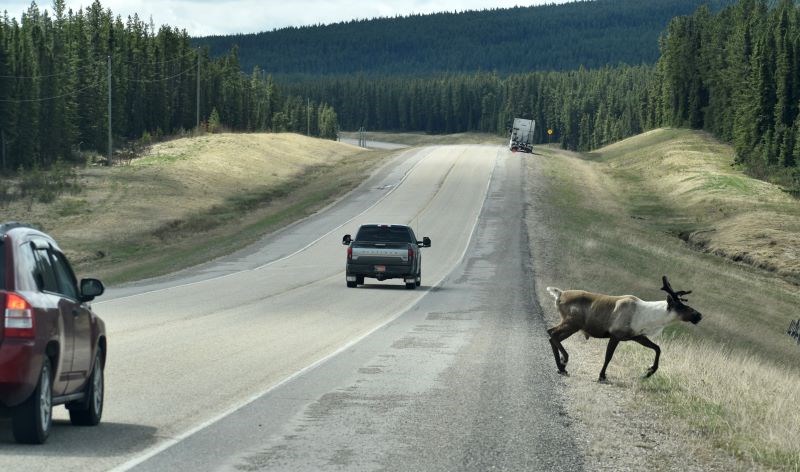
Jason Stockfish | [email protected]
Aseniwuche Winewak Nation’s Caribou Patrol Program reported two woodland caribou were killed by vehicles on Highway 40 over eight days in late May.
The first of the two recent fatalities occurred on May 18 when “a regular resident of the Highway 40 caribou corridor—and the largest bull many say they’ve ever seen—was hit and killed in a road collision involving a pick-up truck,” the CPP explained.
“He was affectionately known as Bruno to our crew,” the program added.
“He found his way into our hearts and provided us with some of our most unique wildlife interactions (and) his unfortunate and preventable death has greatly affected the (CPP) as well as AWN staff.”
On May 26, another bull caribou, estimated to be around three years old, was hit and killed in the Shand Creek region south of Grande Cache.
“We’ve never had (two killed in such a short time span) before,” said Stephanie Leonard, environmental coordinator with AWN.
Caribou Patrol is an Indigenous-led stewardship program created in 2012 in response to declining caribou numbers on AWN’s traditional lands in west-central Alberta.
In its first decade, the organization has recorded seven caribou deaths along Highway 40 between the Muskeg and Berland rivers, including the two recent bulls.
The program mirrors a now-defunct Government of Alberta program called Caribou Cowboys, which was created in the 2000s after more than 30 caribou were hit and killed in just a couple of years.
“We started out looking purely at hunting seasons to see if poaching was a problem,” Leonard said.
“But once we realized it wasn’t, that’s when we moved (our focus) toward highways and migration routes.”
The AWN are continuing to build engagements with the community through social media and outreach efforts, in hopes of creating a sense of public ownership over the success of the program.
In addition to these efforts, the Aseniwuche Winewak people voluntarily stopped harvesting caribou in the early 1970s in support of conserving the animals.
Caribou are most active in the spring as they are migrating.
They tend to spend their winters in the lowlands off the highway, and during this time of year, they are crossing back into the mountains for the warmer months.
“That’s just their migration route. It was there before the highway and hopefully it will be there well after,” Leonard said.
“But we have had quite a few of our woodland caribou change their migrations.”
Currently, there are only around 350 caribou spread out among four west-central herds.
The Little Smoky and À la Pêche caribou herds are the largest at around 100-120 each.
The herd around Narraway has become smaller over the years, and the AWN theorize this is because many caribou are staying in B.C. rather than migrating back to Alberta.
The Red Rock Prairie Creek herd was doing well, but an avalanche killed about a quarter of their numbers in 2019 and they’re still recovering.
“Normally these caribou wouldn’t have been in an area where they could be hit by an avalanche… but a lot of the caribou in that herd don’t migrate anymore,” Leonard said.
“We suspect it’s due to the fact that their winter range is very highly disturbed and has a lot of industry activity.”
With unnatural forces disturbing the natural order, the caribous’ habitat is not as healthy and unbroken as it should be.
“The biggest thing that people can do is push their government representatives and let them know caribou are important, and they need to stop pushing this issue under the rug,” Leonard said.
“There needs to be more voices out there besides the environmental groups and the Indigenous groups, because they aren't listening to us.”
Woodland caribou need old growth forest to survive.
Therefore, limits and regulations on industry in caribou zones are necessary to preserve the areas caribou have naturally existed for time immemorial, Leonard said.
“They need untouched areas where the wolves can’t travel, and the more we affect that, the less of what they need is out there,” she added.
Having dense old growth for caribou is especially important this time of year as it is calving season.
Leonard said that in recent years around 70 per cent of calves are lost to predation.
The CPP also wants speed changes on Highway 40 and the installation of overpasses or underpasses in areas where caribou migrate.
Highway 40 is Alberta’s deadliest highway for caribou, and speed has been a factor in just about every caribou death, noted Leonard.
“Please, slow down, pay attention, and do your part to make Highway 40 safe for all road users and wildlife,” pleaded the CPP on social media.
As a result of limited funds and safety concerns, CPP crews cannot be on duty all day, every day.
“We are heartbroken and out of ideas,” it added.
“We turn to you, the public, to help us find ways to prevent (these) incidents from becoming a pattern.”



